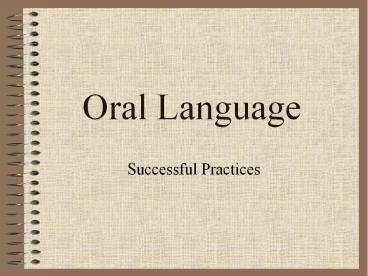Oral Language PowerPoint PPT Presentation
Title: Oral Language
1
Oral Language
- Successful Practices
2
Adapted (with permission) fromSuccessful
Practices with English LearnersA Focus on
OracyAida WalquiDirector, Teacher
Professional Development ProgramWested3rd
Annual Language, Culture, and Education
InstituteApril 5 University of Wisconsin Oshkosh
3
Oral Language DevelopmentTheoretical Base
- Basil Bernstein (1973-1995) Class, codes, and
control. - Restricted codes
- Premised on shared knowledge
- The familiar, context-rich interactions
- Essential for close relationships
- Example Shut the door!
4
- Basil Bernstein (1973-1995) Class, codes, and
control - Elaborated codes
- nothing is taken for granted
- elaboration is indispensable as a tool of
schooling - Example Shut the door so the cold air
doesnt come in.
5
- Do schools expect an elaborated code when
children speak? - If do, why?
- How can you scaffold oral learning to teach
children to see an elaborated code of speech?
6
Scaffolding Oral Language
7
Choose a picture from a lesson.
- Describe the picture
8
Guidelines for the Description
- Where does the scene take place?
- Who is the central character(s) in the picture?
- What does this person look like?
- (sex, height, face, hair,clothes, approximate
age) - What is this person doing?
- Any other relevant information?
9
Language Modeling
- This scene takes place in
- My picture shows
- The picture I have shows a
- The central character in my picture is
- In my picture you can see a
- Wested, Teacher Professional Development, 2002
10
In a Small Group
- Round robin share the description of your
pictures. - After description is complete, you may ask
questions of each other (one per partner) - Now speculate Your task is to create a story
providing creative glue to link the scenes. - Give the story a title. Give the characters
names, details, etc.
11
Post Card Sample
12
(No Transcript)
13
Student produced picture related to lesson picture
14
Student Note to Family in the Time Period Being
Studied
- Dear Mama and Papa,
- Farming is hard work. Feeding the animals,
milking the cows, and tending the crops is a lot
to do. - Love,
- Miguel
15
Note and Postcard Sample
- Students may write their letters on a postcard.
16
What do we know about reading?
- Teachers who invite students to participate in
deep collaborative activities and provide them
with choices increase their motivation to read
and comprehend text. - Wested, Teacher Professional Development, 2002
17
Collaborative Dialogue Writing
- Everybody writes and takes notes.
- 2/3 of the ideas come from the text.
- 1/3 come from your knowledge of life (including
home culture).. - Wested, Teacher Professional Development, 2002
18
Think and Reflect
- Why should all students write?
- Why is copying okay?
- Why is knowledge from life okay to write about?
- Wested, Teacher Professional Development, 2002
19
Teacher Monitors While Children Write
20
(No Transcript)
21
Think and Reflect
- Why do all students write down ideas?
- Why is the teacher monitoring?
- Wested, Teacher Professional Development, 2002
22
Children Share
23
(No Transcript)
24
Think and Reflect
- Why are the children physically close together
during sharing? - Why are the children arranged to see one another
while sharing? - Wested, Teacher Professional Development, 2002
25
What do we know about reading?
- To foster reader autonomy, teachers should offer
students a range of instructional practices,
robust and generative routines, and appropriate
language models that can be appropriated over
time. - Wested, Teacher Professional Development, 2002
26
Final Think and Reflect
- In spite of all this knowledge, comprehension
instruction continues to receive inadequate time
and attention in typical classroom instruction. - Wested, Teacher Professional Development, 2002

